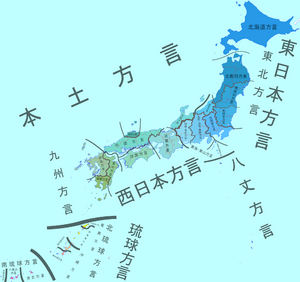| 日本-琉球语系 | |
|---|---|
| Japanese-Ryukyuan | |
| 使用族群 | 大和族、琉球族 |
| 地理分布 | 日本、 琉球、 帕劳 |
| 谱系学分类 | 世界主要语系之一 |
| 分支 | |
| ISO 639-5 | jpx |
| – | |
| Glottolog | japo1237[1] |
 | |
日本语系(英语:Japonic languages),或称日本-琉球语系(英语:Japanese-Ryukyuan languages),是世界主要语系之一,包含日语和琉球语两大分支,使用人口约1.25亿。
介绍
关于日本语与其它语言和语系的关系到目前为止由学者们提出过许多理论:
- 日琉语系:日琉语系这个概念最早由美国的日本学者莱昂·塞拉芬提出[2],后来这一概念受到国际语言学者的普遍接受,根据日琉同祖论,日琉语系的所有语言的祖语都是原始日语(Proto-Japonic)[3]。
- 澳台语系:南岛语与日语也有类似点:元音(母音)有5个,即あ(a)、い(i)、う(u)、え(e)、お(o),不使用双重元音;单词以元音结束;浊音不同于单词之首等,但日本语与南岛语系语言之间缺乏同源词汇。
- 阿尔泰语系:持阿尔泰超语系假说的人认为日语属于阿尔泰语系,但该语系已经在主流学术界上被否定[5][6][7][8][9]。不过,仍有少数学者支持存在这个语系[10]。因此是否存在这个语系,学术界直到现在都存在争议。
分类
日语
琉球语
人造语言
《星界的纹章》中所用的人工语言亚维语亦被其作者归入本语系内。
参见
参考文献
- ↑ Hammarström, Harald; Forkel, Robert; Haspelmath, Martin; Bank, Sebastian (编). 日本-琉球语系. Glottolog 2.7. Jena: Max Planck Institute for the Science of Human History. 2016.
- ↑ Shimabukuro, Moriyo. (2007). The Accentual History of the Japanese and Ryukyuan Languages: a Reconstruction, p. 1.
- ↑ Miyake, Marc Hideo. (2008). Old Japanese: a Phonetic Reconstruction. p.的 66.,第66页,于Google图书
- ↑ Heinrich, Patrick. "What leaves a mark should no longer stain: Progressive erasure and reversing language shift activities in the Ryukyu Islands," First International Small Island Cultures Conference at Kagoshima University, Centre for the Pacific Islands, February 7–10, 2005; citing Shiro Hattori. (1954) Gengo nendaigaku sunawachi goi tokeigaku no hoho ni tsuite ("Concerning the Method of Glottochronology and Lexicostatistics"), Gengo kenkyu (Journal of the Linguistic Society of Japan), Vols. 26/27.
- ↑ "While 'Altaic' is repeated in encyclopedias and handbooks most specialists in these languages no longer believe that the three traditional supposed Altaic groups, Turkic, Mongolian and Tungusic, are related." Lyle Campbell & Mauricio J. Mixco, A Glossary of Historical Linguistics (2007, University of Utah Press), pg. 7.
- ↑ "When cognates proved not to be valid, Altaic was abandoned, and the received view now is that Turkic, Mongolian, and Tungusic are unrelated." Johanna Nichols, Linguistic Diversity in Space and Time (1992, Chicago), pg. 4.
- ↑ "Careful examination indicates that the established families, Turkic, Mongolian, and Tungusic, form a linguistic area (called Altaic)...Sufficient criteria have not been given that would justify talking of a genetic relationship here." R.M.W. Dixon, The Rise and Fall of Languages (1997, Cambridge), pg. 32.
- ↑ "...[T]his selection of features does not provide good evidence for common descent" and "we can observe convergence rather than divergence between Turkic and Mongolic languages--a pattern than is easily explainable by borrowing and diffusion rather than common descent", Asya Pereltsvaig, Languages of the World, An Introduction (2012, Cambridge) has a good discussion of the Altaic hypothesis (pp. 211-216).
- ↑ Georg et al. 1999: 73–74
- ↑ Stefan Georg, Peter A. Michalove, Alexis Manaster Ramer, and Paul J. Sidwell (1999): "Telling general linguists about Altaic". Journal of Linguistics, volume 35, issue 1, pages 65–98.